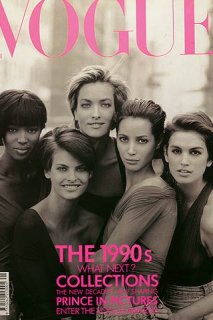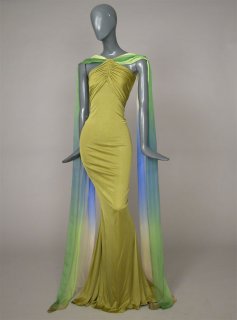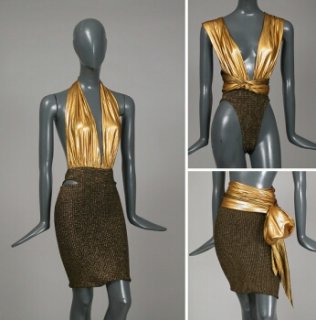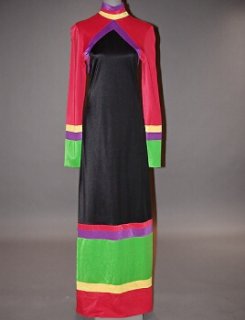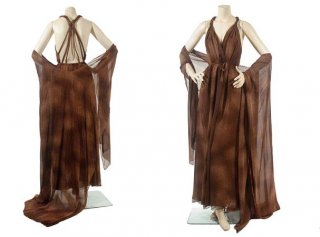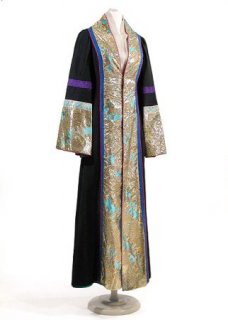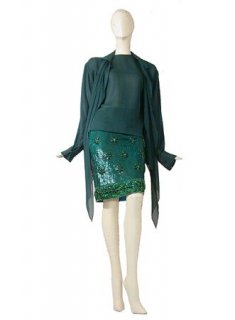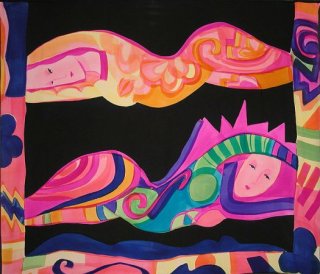- Joined
- Jan 21, 2004
- Messages
- 4,896
- Reaction score
- 3
Wild Child
Brash, mercurial, risk-taking, Giorgio Sant'Angelo was a supernova of the seventies fashion world. He loved color, fabric, and fringes; hated zippers; and aimed to set women free from the traditional wardrobe. But it took until now for the current fashion flock — from John Galliano to Marc Jacobs — to catch up to his genius.
BY DAVID COLMAN
"It was hot. Very, very hot." This is Veruschka's most overpowering memory of that summer day in 1968. She had been up since 6 a.m. on a Vogue fashion shoot, set in a remote location in the Arizona desert. By noon, with the sun directly overhead, she was standing on a rocky ledge wearing a large piece of sheared mink twined, turbanlike, around her head. Her body was swathed in thick, vanilla-colored jersey, tied off with long pieces of leather.
On the one hand, the visual effect was that of a woman who had been kidnapped and tied up in a sleeping bag. But on the other hand — and this is the hand that matters — the effect was cutting-edge, mind-blowing, fashion-doesn't-get-any-better-than-this fabulous.
"At some point," Veruschka says in her rich, German-accented baritone, "it must have been too much. I fainted — tipped over like a tree." It was only after she came to that she realized the outfit wasn't completely impractical: Even though she had fallen onto a slab of solid rock, she recalls, "it didn't hurt at all."
The shoot was the inspiration of Diana Vreeland, the editor of Vogue at the time. Her concept was to send model-of-the-minute Veruschka, her boyfriend, photographer Franco Rubartelli, and her best friend — a young stylist named Giorgio di Sant'Angelo — off on a fashion shoot to the Painted Desert without a single stitch of clothing.
"We had nothing but some yards of fabric, some stones, and some ropes," recalls Veruschka, still a statuesque beauty 34 years later. And yet, where others might see a pile of fabric and clothesline, Sant'Angelo saw clothes. Over the course of the week, he would wrap, drape, and tie Veruschka into enough looks for a small collection — one with more ideas than most of today's large collections, and without a single zipper.
It was that kind of a year. It was the Summer of Love, flower power was ascendant, and Yves Saint Laurent had just introduced the see-through blouse. Koos van den Akker, a young Dutch designer, had set up a sewing machine right on Seventh Avenue in a clever bid to draw attention to his artsy, hand-crafted lace dresses. Not to be outdone, Paco Rabanne had shown mod mini-dresses made of aluminum panels.
"I like myself; I like myself very much," Sant'Angelo said in 1969. "I could never do anything mediocre."
But even amid the tumult, the desert portfolio in the July 1968 Vogue was a fashion shot heard round the world. Just six months later, when Sant'Angelo's ready-to-wear collection debuted, rich in patterns and flowing fabrics — and devoid of buttons and zippers — it appeared he might succeed in setting women free from the structured clothes they had worn for centuries. And when he leapfrogged other more experienced designers to take home the 1970 Coty Award, it seemed as if Sant'Angelo and Halston, the previous year's winner, would rule the new decade.
Some 30 years later, Katie Grand, the editor of Pop, a British youth-culture fashion magazine, was weary. Weary of the same takes on sixties mod and seventies decadence, weary of irony, and weary of minimalism. That was when she saw the Veruschka pictures for the first time, and instantly decided to drag Gisele Bündchen (the Veruschka of the aughts) out to Death Valley and tie the model up in overages of Prada and John Galliano fabric. "It was so striking — it wasn't the kind of obvious reference I'd been seeing," she recalls. "I thought, Let's do this before someone else does."
She was beaten to the punch — by two months — by Italian Vogue, which hit newsstands in July 2001, featuring models Karolina Kourkova and Caroline Ribeiro wrapped up in the desert and shot by Steven Meisel. Soon it seemed the entire fashion world had Sant'Angelo's Saint-Tropez-by-way-of-Haight-Ashbury style on the brain. Kaleidoscopic prints, suede fringe, flowing fabrics, folklore touches, and daring color clashes — all Sant'Angelo signatures — returned to the spring runways in force, from Dolce & Gabbana and Marc Jacobs to Luella Bartley and Christian Dior. As Manhattan vintage dealer Keni Valenti told Grand, style-setters were once again bullish on Sant'Angelo: "Kate Moss and Carmen Kass have been buying it — and Nicholas Ghesquière has bought a lot."
Inacio Ribeiro, of the British design team Clements Ribeiro, became intrigued by Sant'Angelo after seeing repeated references to his work in old copies of American Vogue and Bazaar. Ribeiro began to research Sant'Angelo's career. "He had this amazing way of creating volume," says Ribeiro, whose spring 2002 collection indexed such Sant'Angelisms as loose, Navajo suedes, drawstring closures, hippie embroidery, and fringe galore. "He was incredibly daring in his use of color, pairing bright fluorescents with muted Renaissance colors — really jarring. And all those flying panels everywhere, they gave his clothes this incredible sense of freedom."
Anna Sui agrees. "He really did what I always dreamed a fashion designer did -- make up clothes on the spot, drape them right on the model."
Donna Karan recalls the late designer's haute simplicity. "I've always thought that all you need is a big scarf, and that was his thing, too."
"If you had to pick one designer from the late sixties and the early seventies, he's the one," says Harold Koda, curator of the Metropolitan Museum of Art's Costume Institute, which has an extensive Sant'Angelo collection. "His clothing raised the idea that getting dressed is a social act but doesn't have to a be conforming one."
'I like myself; I like myself very much," Jorge Alberto Imperatrice di Sant'Angelo e Ratti di Desio told Women's Wear Daily in 1969. "I could never do anything mediocre." Certainly, he wasn't raised to be average. Born in 1933 in Florence, he was shortly transferred to his aristocratic family's sprawling cattle ranch in rural Argentina. Falling heavily under the influence of his colorful grandmother — a kind of Diana Vreeland of the pampas — the young Sant'Angelo was pushed to think creatively. At the same time, Grandma was strict, religious, and a fierce critic, one who loved and scolded passionately.
Giorgio did everything he could to get her love and referred to her constantly as his "great inspiration." Entering a ceramics contest at the age of 19, the young Sant'Angelo won first prize: a three-month apprenticeship with Pablo Picasso at his studio in the south of France. The stint with the master modernist would prove as influential as his years with his grandmother; all his life, Sant'Angelo tried to heed Picasso's urgings never to look back or lay back — to keep pushing the boundaries.
After studying architecture and law, Sant'Angelo, at 24, decided to try his hand at animation, creating a short film about a man and a woman — in the form of a point and a line — who meet and decide to make beautiful shapes together. The charming short won him another apprenticeship, to a different kind of studio: Walt Disney, in Burbank, California. He arrived at Disney in January 1962 and departed later that same month, appalled at what he saw as the assembly-line ethic imposed on the creative process. After hitchhiking around the country for several months, he arrived in New York and through a chance meeting began to earn a living interior-designing hotels in the Caribbean.
During his spare time he began tinkering with some of the new plastics he had come across in his work for the hotels, and one day he fashioned some pieces of jewelry out of colored Lucite. A Vogue editor, Cathy di Montezemolo, spotted them and forwarded them to her boss. Vreeland liked what she saw and urged the jewelry manufacturer Richelieu to produce the plastic pieces, which she promptly endorsed on the cover of her magazine. She persuaded a glove-maker — then a dying craft — to make some of Sant'Angelo's designs: another hit. Belts were next, then bags. She urged him to try his hand at clothes, but Sant'Angelo balked, preferring the freedom to design accessories, continue with his fashion styling, and spin one-off creations for his fashionable friends.
"Everything he did was so spectacular but so simple," recalls Polly Mellen, one of Sant'Angelo's closest friends. In 1965, she was a fashion editor at Vogue, and the two of them, together with photographer Richard Avedon, were often sent on sittings with little mandate other than to just create something. "Everything we did was just so much fun — God, how we used to laugh. Dick would just wait so patiently; he knew that Giorgio would give him something fabulous." One such sitting, for Vogue's July 1967 cover, rapidly became an iconic sixties image: the face of Twiggy, with a flower drawn on her cheek in makeup by Sant'Angelo.
But it was after the Veruschka shoot that his entry into full-fledged fashion became inevitable. His riotously colorful first show, in January 1969, which turned Gypsies and peasants into the stuff of high fashion (before Saint Laurent did), was a wild success — Jean Shrimpton modeled the collection on the cover of Vogue's March issue. He followed it with a fall collection dedicated to Native American style, from Incas and Aztecs to Navajos and Eskimos; the show won him the 1970 Coty award. This he followed with a show called "Jane and Cinderella" — deconstructed. In a fit of inspiration the night before the show, he slashed nearly every piece of clothing to ribbons and then showed them in tatters.
Season after season, the clothes and ideas kept coming; it was hard to keep track. "The editors used to say, 'Sometimes there are too many ideas,' " recalls his longtime boyfriend and assistant, Martin Price, now working on a book about the designer. "There would be Egyptians and Greeks and Isadora Duncan — mixed in with the Gypsies!"
Back in 1969, Sant'Angelo had sniffed, "The future is not vinyl astronaut clothes." This was a swipe at the likes of Paco Rabanne and André Courrèges, whose stark, mod designs, using such materials as aluminum and plastic, Sant'Angelo considered both pretentious and uncomfortable — two of the worst crimes fashion could commit. A champion of the beauty of the female body, he also abhorred clothes that sought to reform or reshape an imperfect figure. (Though he wasn't always so spot-on in his forecasts, once declaring, with typical aplomb, "The bikini is the evening dress of the future.")
His clothes, he often proclaimed, were about freedom. Kitty D'Alessio, a close friend of the designer's and former president of Chanel, remembered one season when Sant'Angelo got the idea to sell what he called a whole travel wardrobe in a small leather envelope. Inside, there were a handful of different pieces, all in a rainbow of stretch chiffons: a pair of tights that could double as a bandeau, a halter, a bathing suit, a dress that could be pulled up to be a top or down to be a skirt. "And they would all be in these Day-Glo colors," she says, "except Giorgio would always put in one piece in some awful color, like khaki; that made it his."
Another (perhaps more practical) innovation was his use of the bodysuit. Starting with an embroidered or beaded bodysuit, Sant'Angelo would build and drape a look right onto a model, layering on fabrics and colors and textures. Soon, fashionable women —- Lena Horne, Faye Dunaway, Cher, Isabella Rossellini (who would later wear a Sant'Angelo to the Oscars), Mica Ertegun, Bianca Jagger, and even her husband, Mick —- were returning the favor, lavishing the charismatic Italian with adoration, money, and fame.
The ease and flamboyance of his designs mirrored Sant'Angelo's personal life. In the heyday of wall-to-wall carpeting, his clothes were made for lounging on floor pillows, rapping with friends, drinking white wine, and indulging in Sant'Angelo's drug of choice: a joint. A slim, ebullient man who dressed in his own wild Lycra prints, Sant'Angelo was extra-social and extra-sensual. China Machado, a senior editor at Harper's Bazaar in the seventies, remembers taking Sant'Angelo along to a house she'd rented in Venezuela with several other couples (among them Geraldo Rivera and his second wife Edie Vonnegut). "All Giorgio brought were these very tight jumpsuits, in different colors," she recalls. "One afternoon we were all sitting around the pool when Giorgio came out in one of these jumpsuits, and the construction crew working on the building next door started yelling." Ever the provocateur, Sant'Angelo quickly removed it to reveal a little pair of matching stretch trunks, whereupon the construction crew started making even more noise. "So Giorgio gets up and takes off the swim trunks — to reveal a tiny matching G-string."
The designer's sense of drama extended beyond the runway to his own personal history. When asked by a reporter if he had ever been robbed, Sant'Angelo replied yes, once: A 30-carat blue diamond, a family heirloom, had been stolen from his house in the Fire Island Pines. Why (or, in fact, whether) he kept a 30-carat diamond in the Pines is up for debate. Then there was his name: He had already become "Giorgio" from Jorge in the early sixties, and by the mid-sixties he had swapped Imperatrice for di Sant'Angelo. Ten years later he would change it once more, this time dropping the "di" to fashion a more democratic feel and a better rhythm. That didn't last either; by 1986 he had reinstated it. One close friend remembers the time she dropped by Sant'Angelo's apartment and he answered the door naked except for a mass of purple gel — blond hair dye — on both his head and crotch.
"Giorgio was a great party guy, a lot of fun," recalls Glenn O'Brien, a writer whose ex-wife worked for Sant'Angelo in the seventies. Recreational-drug-wise, "he wasn't in the same league with Halston. But Giorgio didn't need coke to be peppy. He was always up, always had a cigarette in his mouth, always throwing fabric on models."
But try as he might, Sant'Angelo found that as the seventies wore on, he couldn't compete with Halston in matters more important than cocaine consumption. "They were rivals," says O'Brien, "vying for No. 1, and Halston certainly won."
...
Brash, mercurial, risk-taking, Giorgio Sant'Angelo was a supernova of the seventies fashion world. He loved color, fabric, and fringes; hated zippers; and aimed to set women free from the traditional wardrobe. But it took until now for the current fashion flock — from John Galliano to Marc Jacobs — to catch up to his genius.
BY DAVID COLMAN
"It was hot. Very, very hot." This is Veruschka's most overpowering memory of that summer day in 1968. She had been up since 6 a.m. on a Vogue fashion shoot, set in a remote location in the Arizona desert. By noon, with the sun directly overhead, she was standing on a rocky ledge wearing a large piece of sheared mink twined, turbanlike, around her head. Her body was swathed in thick, vanilla-colored jersey, tied off with long pieces of leather.
On the one hand, the visual effect was that of a woman who had been kidnapped and tied up in a sleeping bag. But on the other hand — and this is the hand that matters — the effect was cutting-edge, mind-blowing, fashion-doesn't-get-any-better-than-this fabulous.
"At some point," Veruschka says in her rich, German-accented baritone, "it must have been too much. I fainted — tipped over like a tree." It was only after she came to that she realized the outfit wasn't completely impractical: Even though she had fallen onto a slab of solid rock, she recalls, "it didn't hurt at all."
The shoot was the inspiration of Diana Vreeland, the editor of Vogue at the time. Her concept was to send model-of-the-minute Veruschka, her boyfriend, photographer Franco Rubartelli, and her best friend — a young stylist named Giorgio di Sant'Angelo — off on a fashion shoot to the Painted Desert without a single stitch of clothing.
"We had nothing but some yards of fabric, some stones, and some ropes," recalls Veruschka, still a statuesque beauty 34 years later. And yet, where others might see a pile of fabric and clothesline, Sant'Angelo saw clothes. Over the course of the week, he would wrap, drape, and tie Veruschka into enough looks for a small collection — one with more ideas than most of today's large collections, and without a single zipper.
It was that kind of a year. It was the Summer of Love, flower power was ascendant, and Yves Saint Laurent had just introduced the see-through blouse. Koos van den Akker, a young Dutch designer, had set up a sewing machine right on Seventh Avenue in a clever bid to draw attention to his artsy, hand-crafted lace dresses. Not to be outdone, Paco Rabanne had shown mod mini-dresses made of aluminum panels.
"I like myself; I like myself very much," Sant'Angelo said in 1969. "I could never do anything mediocre."
But even amid the tumult, the desert portfolio in the July 1968 Vogue was a fashion shot heard round the world. Just six months later, when Sant'Angelo's ready-to-wear collection debuted, rich in patterns and flowing fabrics — and devoid of buttons and zippers — it appeared he might succeed in setting women free from the structured clothes they had worn for centuries. And when he leapfrogged other more experienced designers to take home the 1970 Coty Award, it seemed as if Sant'Angelo and Halston, the previous year's winner, would rule the new decade.
Some 30 years later, Katie Grand, the editor of Pop, a British youth-culture fashion magazine, was weary. Weary of the same takes on sixties mod and seventies decadence, weary of irony, and weary of minimalism. That was when she saw the Veruschka pictures for the first time, and instantly decided to drag Gisele Bündchen (the Veruschka of the aughts) out to Death Valley and tie the model up in overages of Prada and John Galliano fabric. "It was so striking — it wasn't the kind of obvious reference I'd been seeing," she recalls. "I thought, Let's do this before someone else does."
She was beaten to the punch — by two months — by Italian Vogue, which hit newsstands in July 2001, featuring models Karolina Kourkova and Caroline Ribeiro wrapped up in the desert and shot by Steven Meisel. Soon it seemed the entire fashion world had Sant'Angelo's Saint-Tropez-by-way-of-Haight-Ashbury style on the brain. Kaleidoscopic prints, suede fringe, flowing fabrics, folklore touches, and daring color clashes — all Sant'Angelo signatures — returned to the spring runways in force, from Dolce & Gabbana and Marc Jacobs to Luella Bartley and Christian Dior. As Manhattan vintage dealer Keni Valenti told Grand, style-setters were once again bullish on Sant'Angelo: "Kate Moss and Carmen Kass have been buying it — and Nicholas Ghesquière has bought a lot."
Inacio Ribeiro, of the British design team Clements Ribeiro, became intrigued by Sant'Angelo after seeing repeated references to his work in old copies of American Vogue and Bazaar. Ribeiro began to research Sant'Angelo's career. "He had this amazing way of creating volume," says Ribeiro, whose spring 2002 collection indexed such Sant'Angelisms as loose, Navajo suedes, drawstring closures, hippie embroidery, and fringe galore. "He was incredibly daring in his use of color, pairing bright fluorescents with muted Renaissance colors — really jarring. And all those flying panels everywhere, they gave his clothes this incredible sense of freedom."
Anna Sui agrees. "He really did what I always dreamed a fashion designer did -- make up clothes on the spot, drape them right on the model."
Donna Karan recalls the late designer's haute simplicity. "I've always thought that all you need is a big scarf, and that was his thing, too."
"If you had to pick one designer from the late sixties and the early seventies, he's the one," says Harold Koda, curator of the Metropolitan Museum of Art's Costume Institute, which has an extensive Sant'Angelo collection. "His clothing raised the idea that getting dressed is a social act but doesn't have to a be conforming one."
'I like myself; I like myself very much," Jorge Alberto Imperatrice di Sant'Angelo e Ratti di Desio told Women's Wear Daily in 1969. "I could never do anything mediocre." Certainly, he wasn't raised to be average. Born in 1933 in Florence, he was shortly transferred to his aristocratic family's sprawling cattle ranch in rural Argentina. Falling heavily under the influence of his colorful grandmother — a kind of Diana Vreeland of the pampas — the young Sant'Angelo was pushed to think creatively. At the same time, Grandma was strict, religious, and a fierce critic, one who loved and scolded passionately.
Giorgio did everything he could to get her love and referred to her constantly as his "great inspiration." Entering a ceramics contest at the age of 19, the young Sant'Angelo won first prize: a three-month apprenticeship with Pablo Picasso at his studio in the south of France. The stint with the master modernist would prove as influential as his years with his grandmother; all his life, Sant'Angelo tried to heed Picasso's urgings never to look back or lay back — to keep pushing the boundaries.
After studying architecture and law, Sant'Angelo, at 24, decided to try his hand at animation, creating a short film about a man and a woman — in the form of a point and a line — who meet and decide to make beautiful shapes together. The charming short won him another apprenticeship, to a different kind of studio: Walt Disney, in Burbank, California. He arrived at Disney in January 1962 and departed later that same month, appalled at what he saw as the assembly-line ethic imposed on the creative process. After hitchhiking around the country for several months, he arrived in New York and through a chance meeting began to earn a living interior-designing hotels in the Caribbean.
During his spare time he began tinkering with some of the new plastics he had come across in his work for the hotels, and one day he fashioned some pieces of jewelry out of colored Lucite. A Vogue editor, Cathy di Montezemolo, spotted them and forwarded them to her boss. Vreeland liked what she saw and urged the jewelry manufacturer Richelieu to produce the plastic pieces, which she promptly endorsed on the cover of her magazine. She persuaded a glove-maker — then a dying craft — to make some of Sant'Angelo's designs: another hit. Belts were next, then bags. She urged him to try his hand at clothes, but Sant'Angelo balked, preferring the freedom to design accessories, continue with his fashion styling, and spin one-off creations for his fashionable friends.
"Everything he did was so spectacular but so simple," recalls Polly Mellen, one of Sant'Angelo's closest friends. In 1965, she was a fashion editor at Vogue, and the two of them, together with photographer Richard Avedon, were often sent on sittings with little mandate other than to just create something. "Everything we did was just so much fun — God, how we used to laugh. Dick would just wait so patiently; he knew that Giorgio would give him something fabulous." One such sitting, for Vogue's July 1967 cover, rapidly became an iconic sixties image: the face of Twiggy, with a flower drawn on her cheek in makeup by Sant'Angelo.
But it was after the Veruschka shoot that his entry into full-fledged fashion became inevitable. His riotously colorful first show, in January 1969, which turned Gypsies and peasants into the stuff of high fashion (before Saint Laurent did), was a wild success — Jean Shrimpton modeled the collection on the cover of Vogue's March issue. He followed it with a fall collection dedicated to Native American style, from Incas and Aztecs to Navajos and Eskimos; the show won him the 1970 Coty award. This he followed with a show called "Jane and Cinderella" — deconstructed. In a fit of inspiration the night before the show, he slashed nearly every piece of clothing to ribbons and then showed them in tatters.
Season after season, the clothes and ideas kept coming; it was hard to keep track. "The editors used to say, 'Sometimes there are too many ideas,' " recalls his longtime boyfriend and assistant, Martin Price, now working on a book about the designer. "There would be Egyptians and Greeks and Isadora Duncan — mixed in with the Gypsies!"
Back in 1969, Sant'Angelo had sniffed, "The future is not vinyl astronaut clothes." This was a swipe at the likes of Paco Rabanne and André Courrèges, whose stark, mod designs, using such materials as aluminum and plastic, Sant'Angelo considered both pretentious and uncomfortable — two of the worst crimes fashion could commit. A champion of the beauty of the female body, he also abhorred clothes that sought to reform or reshape an imperfect figure. (Though he wasn't always so spot-on in his forecasts, once declaring, with typical aplomb, "The bikini is the evening dress of the future.")
His clothes, he often proclaimed, were about freedom. Kitty D'Alessio, a close friend of the designer's and former president of Chanel, remembered one season when Sant'Angelo got the idea to sell what he called a whole travel wardrobe in a small leather envelope. Inside, there were a handful of different pieces, all in a rainbow of stretch chiffons: a pair of tights that could double as a bandeau, a halter, a bathing suit, a dress that could be pulled up to be a top or down to be a skirt. "And they would all be in these Day-Glo colors," she says, "except Giorgio would always put in one piece in some awful color, like khaki; that made it his."
Another (perhaps more practical) innovation was his use of the bodysuit. Starting with an embroidered or beaded bodysuit, Sant'Angelo would build and drape a look right onto a model, layering on fabrics and colors and textures. Soon, fashionable women —- Lena Horne, Faye Dunaway, Cher, Isabella Rossellini (who would later wear a Sant'Angelo to the Oscars), Mica Ertegun, Bianca Jagger, and even her husband, Mick —- were returning the favor, lavishing the charismatic Italian with adoration, money, and fame.
The ease and flamboyance of his designs mirrored Sant'Angelo's personal life. In the heyday of wall-to-wall carpeting, his clothes were made for lounging on floor pillows, rapping with friends, drinking white wine, and indulging in Sant'Angelo's drug of choice: a joint. A slim, ebullient man who dressed in his own wild Lycra prints, Sant'Angelo was extra-social and extra-sensual. China Machado, a senior editor at Harper's Bazaar in the seventies, remembers taking Sant'Angelo along to a house she'd rented in Venezuela with several other couples (among them Geraldo Rivera and his second wife Edie Vonnegut). "All Giorgio brought were these very tight jumpsuits, in different colors," she recalls. "One afternoon we were all sitting around the pool when Giorgio came out in one of these jumpsuits, and the construction crew working on the building next door started yelling." Ever the provocateur, Sant'Angelo quickly removed it to reveal a little pair of matching stretch trunks, whereupon the construction crew started making even more noise. "So Giorgio gets up and takes off the swim trunks — to reveal a tiny matching G-string."
The designer's sense of drama extended beyond the runway to his own personal history. When asked by a reporter if he had ever been robbed, Sant'Angelo replied yes, once: A 30-carat blue diamond, a family heirloom, had been stolen from his house in the Fire Island Pines. Why (or, in fact, whether) he kept a 30-carat diamond in the Pines is up for debate. Then there was his name: He had already become "Giorgio" from Jorge in the early sixties, and by the mid-sixties he had swapped Imperatrice for di Sant'Angelo. Ten years later he would change it once more, this time dropping the "di" to fashion a more democratic feel and a better rhythm. That didn't last either; by 1986 he had reinstated it. One close friend remembers the time she dropped by Sant'Angelo's apartment and he answered the door naked except for a mass of purple gel — blond hair dye — on both his head and crotch.
"Giorgio was a great party guy, a lot of fun," recalls Glenn O'Brien, a writer whose ex-wife worked for Sant'Angelo in the seventies. Recreational-drug-wise, "he wasn't in the same league with Halston. But Giorgio didn't need coke to be peppy. He was always up, always had a cigarette in his mouth, always throwing fabric on models."
But try as he might, Sant'Angelo found that as the seventies wore on, he couldn't compete with Halston in matters more important than cocaine consumption. "They were rivals," says O'Brien, "vying for No. 1, and Halston certainly won."
...

















